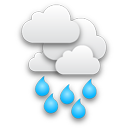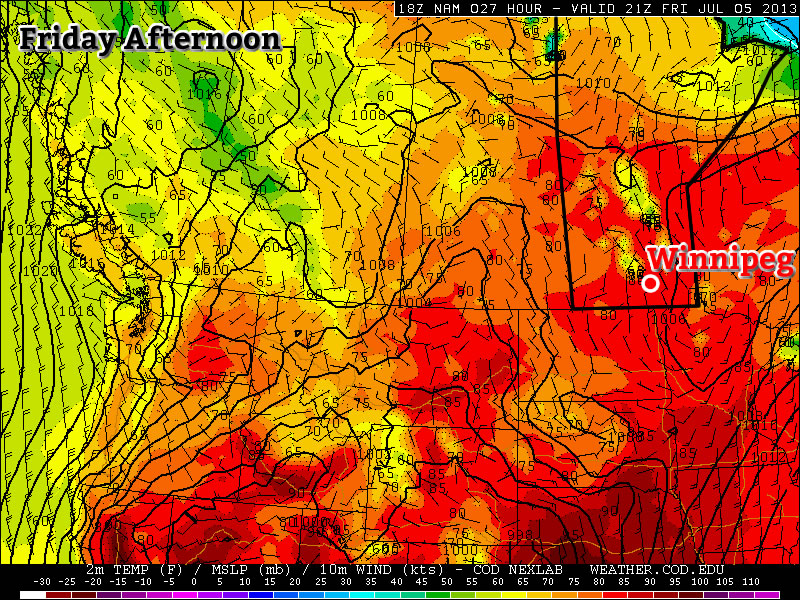Southern Manitoba is on tap for another complicated significant precipitation event for the second half of the week as another strong low stalls over North Dakota. With a good moisture feed northwards from the Gulf of Mexico, significant convection will fire up through the Northern Plains and wrap around the low into Southern Manitoba. If this sounds like last week’s system…well, it is. Scott had a keen eye to mention it in Monday’s post and this system certainly has the potential to have a significant impact on some communities in the Red River Valley, especially those near the western escarpment who were deluged with up to 8 inches of rain on the May long weekend.
So just how much rain will fall and when? Read on to find out.
Today & Tonight
 20°C
20°C /
14°CA mix of sun and cloud. Increasing cloud overnight.
Today will be a fairly nice day with a mix of sun and cloud as we push to a high of around 20°C. There may be some fog patches through the Red River Valley this morning – and some may be dense – but they should burn off by mid-morning. Winds will remain fairly light out of the west at around 10–15km/h.
Clouds will begin to push into the Red River Valley from the south overnight as thunderstorms fire up in North Dakota. There may be a scattered shower or two overnight, but the main area of rain should stay south of Winnipeg until Thursday morning.
Thursday & Friday
The main event begins Thursday morning as rain pushes up from North Dakota into Southern Manitoba. This area of rain may have thunderstorms embedded in it and will likely produce moderate accumulations as it pushes northwards. This band will continue to push northwards until it’s fully developed along the deformation zone resting along a line through the Manitoba Parkland and Interlake regions. It will likely rain through most of the day across all regions of Southern Manitoba before tapering off Thursday night. The temperature, for those who still like to know despite it raining all day, should climb to around 19–20°C.
Thursday 20°C
20°C /
14°CRain beginning in the morning & tapering off overnight. 15-25mm generally.
Friday 20°C
20°C /
9°CRain or thunderstorms beginning by midday, tapering off early Saturday. 10-20mm generally.
It’s likely we’ll get a 6–12 hour reprieve from the rain sometime overnight Thursday into Friday morning; the exact timing of this break will depend on two particular things:
- When the moisture first arrives in Southern Manitoba
- The exact placement of the low pressure centre in North Dakota.
It may happen a little bit earlier or later, and if the low ends up further south than currently forecast, the break may not occur for places in the Northern Red River Valley, just the south. But at this point it does look likely that we’ll see a reprieve from the rain for a little bit.
On Friday morning the rain will start up again as significant instability develops along a trowal laying across the Red River Valley. There’s a decent chance that we’ll see a thunderstorm or two; whether or not they’ll be severe is too early to tell, but there may be a threat for hail or even an isolated, weak tornado formed from the steep low-level lapse rates and vorticity rich environment near the upper low. At the moment, it looks like the best bet for any thunderstorm activity would be close to or just south of the U.S. border, but we’ll keep an eye out and post updates below. The rain/thunderstorm activity will gradually move southwards and eastwards through the day and night. It won’t be until Saturday morning that all the precipitation leaves the province as the upper low finally pushes eastwards.
The Convective Element: Heavy Rain
The biggest unknown right now is exactly how convective things will be. As mentioned above, the storm-total rainfall accumulations for this event will likely sit around 30–50mm (1.5–2”) for most areas in Southern Manitoba. Any convection or thunderstorms have the potential to dramatically increase that amount as does any upslope flow along the escarpment.

Estimated storm-total precipitation by Saturday morning.
Two areas of concern exist. First, over the western Red River Valley and SW Mantioba northward into the Interlake; as mentioned before, generally 30–50mm are expected, but there’s potential for significant embedded convection to exist within the area of rain, and localized accumulations of much greater than that are possible. At this point, it looks most likely that the worst-case scenarios would top out at around 3“ total accumulation (75mm) by Saturday morning, but this early it’s impossible to say. The second area of concern are for the upslope environments of the western escarpment of the Red River Valley and Parkland regions. A strong north-easterly wind will be in place through the duration of this event which will provide additional lift and enhanced precipitation to communities close to these features. With the last system, which was similar to this one in many ways, rainfall accumulations were about 5–8” along the escarpment, depending on location. Any people living in regions that were hit hard by the last system may want to make preparations for another significant rainfall event. Again, at this point it’s only safe to say that more than 4” is possible in these locations, not that they will for sure get higher amounts.
We’ll keep a close eye on this system as it develops. Being convective in nature it will be inherently complex, but we’ll provide updates below. Live in Southern Manitoba and have a question about this system? Ask in the comments below and we’ll be happy to try and get an answer for you!



